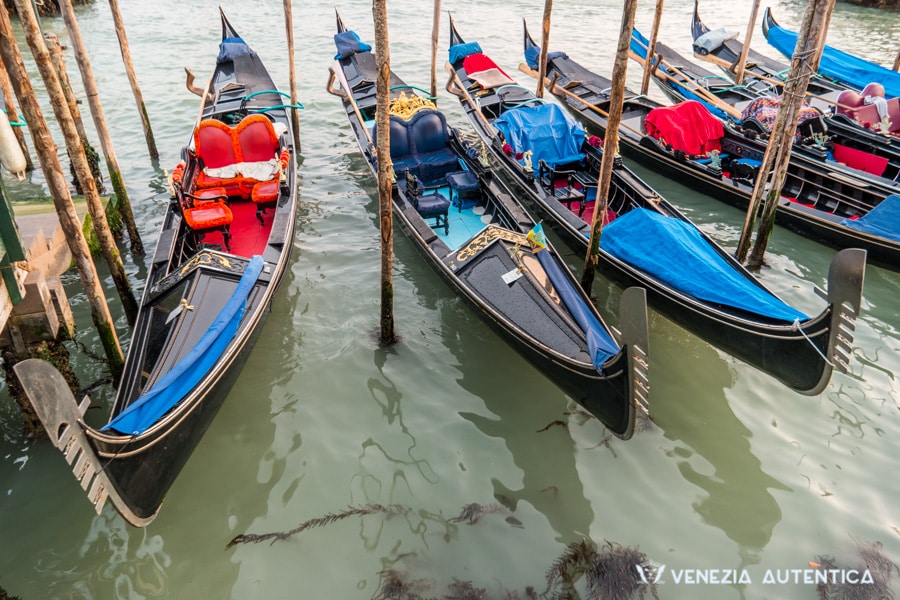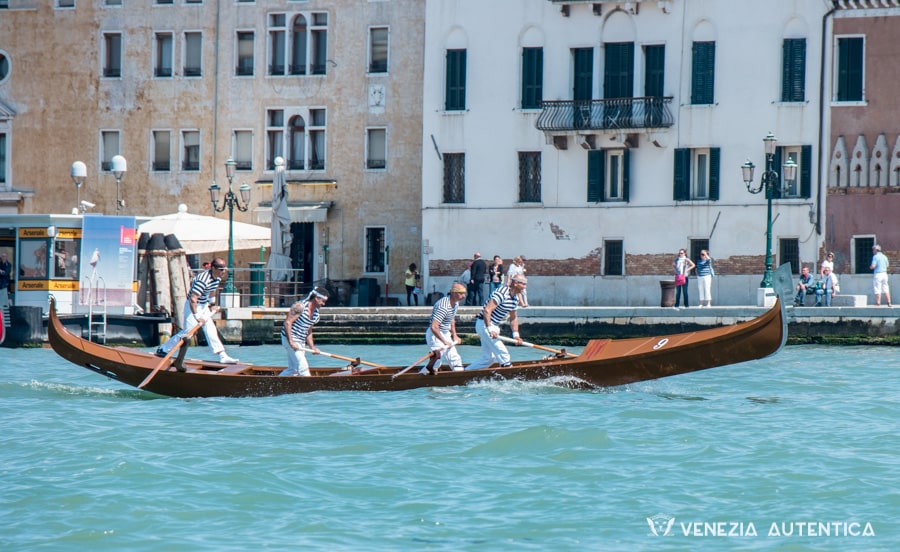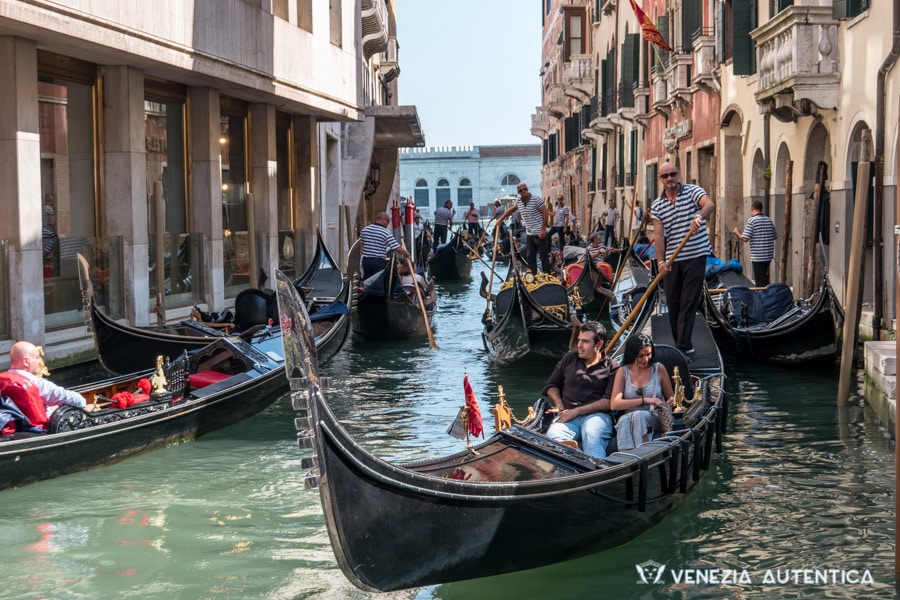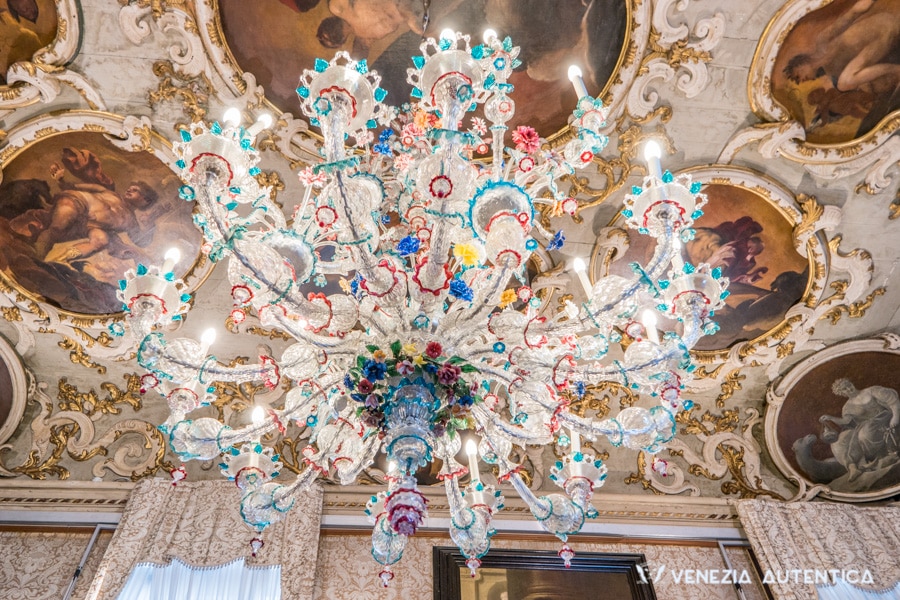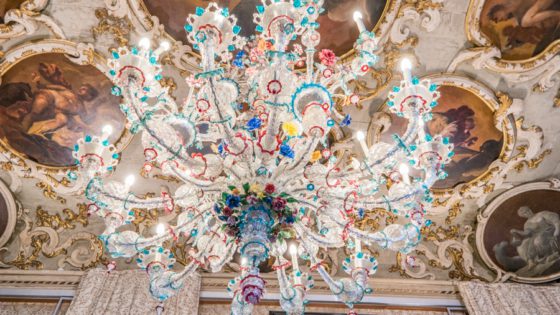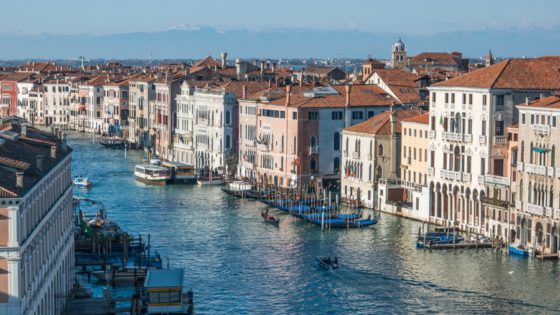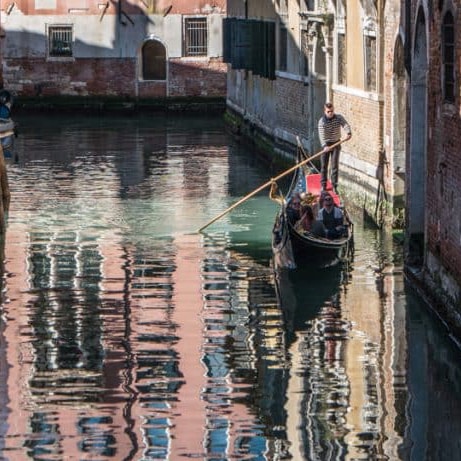Everything and some more about the Venice Gondola
We all know what a gondola in Venice is, right?
“It’s the boat of the gondoliers!” – you say.
Well, that’s a good starting point, but there is so much more to it!
And our article about the Venice gondola will tell you all about it.
Related: Want to go on a gondola ride? Here’s everything you need to know!
Proceed to our article on the Venetian gondola below, to become a true expert on the matter. Or use the Interactive Index if you’re looking for something specific.
Interactive Index
- What is a gondola?
- Similarities between the gondola and other Venetian boats
- Unique features of Venetian gondolas
- Black gondolas are the most famous Venetian boats
- Not all black boats used for tours in Venice are gondolas
- Not all gondolas are black
- Gondolas can be colourful or plain, just like the other traditional Venetian boats
- The sports gondolas are less fancy than their cousins
- The first gondola
- An evolving shape
- Gondola as a symbol of power
- The reason why all gondolas in Venice were black
- The final shape of the Venice Gondola is designed for better one-man rowing
- Gondola rides in Venice determined the look of “modern” gondolas
Or you might be looking for
What is a gondola?
The Gondola is the most famous traditional Venetian boat. It is an 11 m long and 1,42 m wide handmade boat, built with 280 pieces of 8 different kinds of wood, weighing about 400 kg. Gondolas are built in traditional Venetian dockyards called “squeri,” and every gondola needs about six months to be made. The final cost of a gondola is around 40.000 euros.
General information about the Gondola in Venice
Below you will find crucial information about the Venetian gondola, such as its measures and the differences with other traditional Venetian rowing boats. Ready?
Similarities between the gondola and other Venetian boats
There are 3 things in common to all traditional Venetian rowing boats:
- All are flat bottomed. Traditional Venetian rowing boats don’t have a keel!
- The don’t have a rudder. The rower at the back of the boat stirs the boat by pivoting an oar in an (open) oarlock, a forcola.
- Rowing is performed standing up, looking forward, and pushing.
These characteristics are standard in all traditional Venetian rowing boats, as they are a consequence of the shallow lagoon in which Venice was built.
The flat bottom and the absence of the rudder allowed Venetian boats to navigate over very shallow waters. Similarly, the standing position gave rowers the opportunity to see in advance which route to take. In fact, rowers can understand the depth of the water ahead by how the waves move on the surface.
Apart for its elegance and beauty, there are other elements that set the gondola apart from other Venetian rowing boats.
Unique features of Venice gondola
Two characteristics of the gondola are quite known. First, the gondola is asymmetric. Second, it is stirred from an elevated position at the stern. However, both these two features are not unique and shared with the lesser known “pupparin” boat.
Unlike any other boat, however, the gondola has a unique shape which keeps only 60% of the length submerged. Moreover, the boat is characterized by two peculiar ornaments, the big “fero da prova” on the front and the smaller “riço” at the back of the boat.
The front ornament, in particular, is an element that is not just decorative and part of the tradition, but also necessary as it adds weight to the bow of the gondola, counterbalancing the weight of the gondolier at the stern!
For centuries, gondolas have been a crucial element of Venetian life. Today, things are a bit different.
The gondola in Venice today
Blak gondolas are the most famous boats in Venice
Today, Venetian gondolas are most known as a black boat used in Venice for tours through the narrow canals of the city. Gondoliers, in fact, offer visitors the possibility to ride on a gondola through Venice for a fixed price of 80 euros for a 25-30 minutes tour.
As of today, there are only 260 to 280 such work gondolas, for a total of 430+ gondoliers and 160+ substitutes. However, there are few things worth mentioning.
Not all black boats used for tours in Venice are gondolas
Gondolas are one (the most famous, indeed) of several types Venetian boats, and they are not the only type of boat used for tours. Also “sandolo” boats, in fact, are used for tours through Venice. For obvious reasons, those who row a “sandolo” for work, are not called “gondolieri,” but “sandolisti.”
Not all gondolas are black
Work gondolas are all black, no doubt, but gondolas exist in many other colors! Think of the car models of the taxis in your city. Taxis might well be yellow, but that does not imply that all such car models must be yellow. Work gondolas must be black, but there are over 100 gondolas which are not used for work!
Rowing, in fact, can also be a sport or a leisure. It should come as no surprise that gondolas, the queens of all traditional Venetian boats, are the most appreciated boat amongst athletes and Venetian rowing lovers.
Gondolas can be colorful or plain, like the other traditional Venetian boats
Gondolas used for leisure typically retain the color of wood. Few can even be painted in black. In no case, however, do they have all the decorations, seats and pillows typical of work gondolas.
Most sports gondolas, on the other hand, belong to clubs and are painted with the according colors.
An exception are the gondolas part of the town hall fleet, which are painted in plain bright colors. Those boats, and other type of traditional Venetian boats, are used by rowers during official rowing competitions.
The sports gondola are less fancy than their cousins
What is peculiar about sports gondolas and other Venetian rowing boats used for competitions, is that they are stripped off everything that is not necessary for the race. Such boats, in fact, have no benches, no seats, and no floor!
The only “paioli,” the wooden tiles which make up the floor on which to stand, that are kept in competitions boats are those on which rowers need to put their feet on while rowing!
Now you know everything about modern times gondola in Venice, but the origins of the gondola date far back in the past.
Want more tips, tools and stories from Venice, Italy?
We're on a mission to make it easy and fun to discover and support the authentic Venice. Try our email and see for yourself!
The origins of the gondola
The first gondola
The word “gondola” was first used by the Doge Vitale Falier back in 1093 C.E., but it’s origin stem from a boat, “scaula,” in use since early 900.
Compared to today’s gondola, the original version was much broader, much shorter, and symmetrical. Bow and stern laid flatter than those of today, and the front and rear ornaments of the ancient gondola were but simple metal blades.
The evolving shape of the gondola in Venice
In late 15-hundred, gondola makers started changing the shape of the gondola. They made longer and thinner hull, whose extremities came out of the water.
These changes were necessary due to the growth of the city and the need to navigate through a multitude of narrow canals. The new gondolas were easier and faster to maneuver as a smaller portion of the boat was submerged, diminishing friction.
The gondola in Venice as a symbol of power
With this new design, the gondola soon became a favorite amongst Venetians. In fact, in 1600 C.E. there were over 10.000 gondolas in Venice!
The gondolas, however, became also a symbol of power for Venetian families, which started decorating their gondolas in magnificent ways.
The final shape of Venice Gondola is designed for better one-man rowing
During 1800, the gondola’s length reached 11 m, the same as today, and its stern and bow were lifted even farther.
It was only at the beginning of the XX century, however, that the gondola reached its final shape, with an even higher stern and bow, and a strong asymmetry, which makes it easier for the gondolier to control the boat.
The reason why all gondolas in Venice were black
Venetian families spent so much money and energy to have the most beautiful and luxurious gondolas, that the Serenissima government had to intervene!
On the 8th of October 1562, in fact, the Venice Senate decided to halt this “fever” and passed a law that forced all gondolas to be painted in black.
Gondola rides in Venice determined the look of ``modern`` gondolas
The gondolas we see today, however, are different from those of the past for one more reason: they lack the “felze.”
The “felze” was a removable shell made of wood and metal, that covered the passengers. It was used and much appreciated for two simple reasons: it shielded passengers from the cold wind in the winter and the hot sun in the summer, and it protected them from prying eyes.
In fact, Venice was the city of parties, luxury, masks, and sex, and the felze was an essential part of the gondola for hundreds of years!
The felze is thought to have been abandoned due to the growing number of tourists coming to Venice since early 19hundred.
Visitors didn’t appreciate much the intimacy of this covered cabin, as the reason for most of them to board a gondola was to see the city, rather than having an intimate encounter.
Now that you know everything about the gondola, do you know what’s missing? Going on a gondola ride!
For those of you who want even more details about Venetian gondola, we have explained a few more aspects of this fascinating boat below.
Curiosities about the Gondola in Venice:
Why is the gondola asymmetric?
We mentioned before that the gondola evolved to become asymmetric to improve maneuverability. But why would something asymmetrical be easier to stir than something which is symmetrical? Right?! Well, let’s explain it better.
On every Venetian boat, the boat is stirred from the back. The rower at the back pivots a long oar on the oarlock that is at his right. The moment the rower PUSHES the oar, which is on the right of the boat, the boat rotates to the left.
In the case of the gondola, however, its asymmetric shape tends to make the boat turn to the right. This way, the forces created by the natural form of the boat and the rowing of the gondolier are counterbalanced and make it easy to go straight, even though the rowing happens only on one side.
Note: Despite being symmetrical, all Venetian boats can be rowed only by one person. However, on such boats, the counter-force that has to be applied by the rower to keep the boat straight is much higher than the force needed on a gondola!
Why does the Venetian oarlock have such a strange shape?
The forcola, the beautiful Venetian oarlock, has such a peculiar shape as it gives the rower the possibility of pivoting its oars on different spots.
The oarlock makes it possible to row forward slowly, row forward fast, turn quickly, slow down, row backward, and finally stop the boat.
What else has to be noted is the fact that the “forcola” is not an oarLOCK. The forcola, in fact, is open and the oar can be quickly removed from it, making it possible to promptly park the boat or avoid striking other boats with it.
What's the difference with punting?
Venetian rowing is entirely different from punting, as the propulsion of the boat is given by the displacement of water caused by the movement of the oar.
Unlike poles used for punting, the blade of the Venetian oar is broad and has two sides.
One side of the oar has a hydrodynamic edge that is used for “breaking” the resistance caused by water during the pushing, while the other side is smooth.
How can I become a gondolier?
It’s highly unlikely for any person that was not born in Venice to have a chance at becoming a gondolier. It’s a fact.
Moreover, in the last preliminary examination to become a gondolier in May 2018, 60 people passed the test. However, only 5 of them did not have a gondolier as a relative.
How does a Venetian become a gondolier?
Passing the preliminary examination is just the first step. After, one must follow classes of Venetian rowing, Venetian history, and language classes, organized by the gondola guild.
Finally, it’s time for the final and hardest examination:
Rowing a gondola during a busy working day.
Passing the final exam gives one the title of “sostituto gondoliere,” a substitute.
The job of a substitute is to row a gondola on behalf of a gondolier who owns a gondola license granted by the city. The revenue generated by the substitute is then split between the substitute and the gondolier.
If a substitute works on behalf of only one gondolier, he keeps 60% of the revenue. If a substitute works for more gondoliers, his share drops to 50%.
A gondolier has the opportunity to either have a substitute work in his place and keep a good share of the revenue or work by himself and keep 100% of it.
That is the reason why all substitutes want to own a gondola license. There are two ways for a substitute to become a gondolier: he either buys a gondola license from a gondolier who intends to retire or waits until the town hall hands out a few more licenses.
While in theory it is not permitted to sell a city license, it is common practice and is, actually, the most common way to become a gondolier, despite the fact that the price of a license is several hundred thousand euros.
In fact, permits are handed out by the city only once every few (sometimes many) years, and only a dozen at a time.
Are there women gondoliers?
In August 2010, Giorgia Boscolo became Venice’s first official gondolier. (Before her, Alex Hai obtained to work as a gondolier for hotels legally, despite not having a license).
Today, there are a few women gondoliers, and more will be coming very soon!
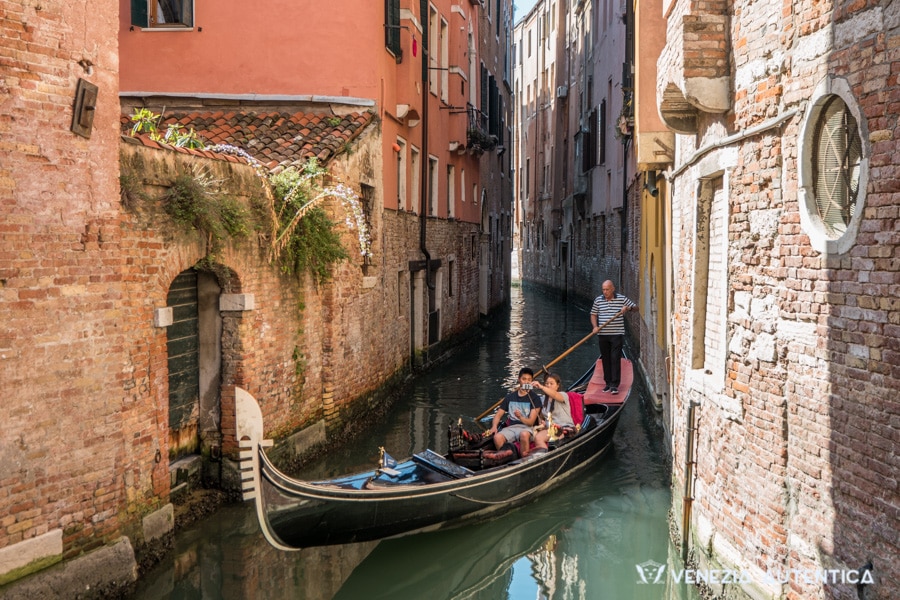
Walk and Gondola Experience
Learn moreIf you’d like to know even more things about the gondola, feel free to check out our articles about the gondola front ornament and about gondola rides!
I'm visiting Venice. Why should I follow your recommendations?
The way you visit Venice has an impact both on the quality of your experience and on Venice itself. Chilling, exploring, shopping, eating and drinking where the locals do, can make a huge impact both on the memories you bring home and on the local economy and community.
Home >> Venice and Venetians >> Venice Explained >> You’re Here
Facts, Curiosities, History of Venice, Italy
More about life in Venice, Italy

